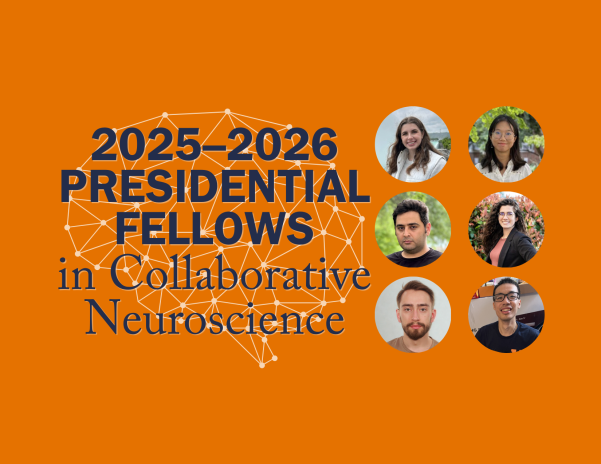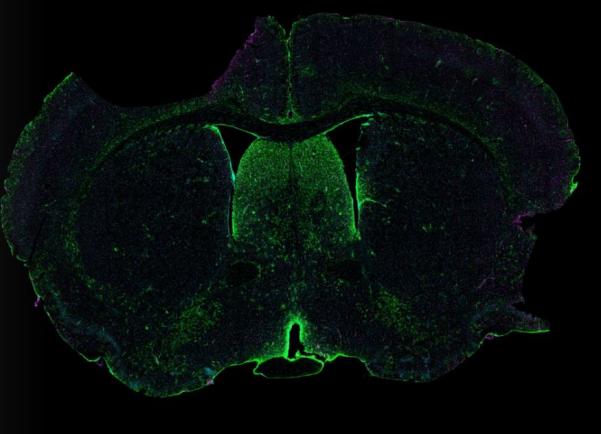Presidential Fellowship in Collaborative Neuroscience
The Provost's Office, in collaboration with the UVA Brain Institute, is proud to support the presidential graduate fellowship program to promote cross-Grounds collaborative neuroscience research.
We seek to bring together neuroscientists from different divisions and UVA Schools (e.g., College of Arts & Sciences, School of Medicine, School of Engineering & Applied Sciences) to tackle important questions and perform transformative work that will differentiate our research enterprise. Projects may be on any subject related to neuroscience. Evidence of prior collaboration is not required, and the creation of new partnerships is encouraged.
This opportunity is open to current 2nd and 3rd graduate students, and competitive applications will provide evidence that the candidate will be jointly guided in a collaborative, multidisciplinary environment on a synergistic project with the potential to generate transformative science. The fellowship will provide $38,000 toward living support, tuition, fees, and/or health insurance for one year. All remaining expenses should be covered by the mentor(s), department, or School, and all fellows will receive $38,000 in living support (wages or stipend) regardless of School. Fellowship awards are not eligible for renewal. Projects that are currently receiving or have within the last two years received Brain Institute support are not eligible for additional funding.
Awarded fellows and their mentors are expected to attend the annual Presidential Fellows in Collaborative Neuroscience event held at both the start and end of their fellowship term. Fellows will deliver a short talk at their end-of-term event. Fellows and mentors will also be asked to participate in Brain Institute events and provide a final report at the completion of the fellowship term. Awarded fellows and their mentors must also submit an individual fellowship proposal to an external funding organization (e.g., NIH F30/F31/F99/K grant, Ford Foundation, or other similar grants from other external agencies) within six months of completion of the fellowship term. Mentors are also expected to participate in future review of program applications.
Application Components:
Candidate (Graduate Student):
- Specific Aims/Objectives (1 page)
- Research Strategy/Project Description (2 pages):
- Scientific Premise: Provide the context for the proposed research training project.
- Approach: Describe the overall strategy, methodology, and analyses to be used to accomplish the project’s specific aims or objectives.
- Timeline: Include the planned activities relevant to the research project over fellowship term.
- Goals & Preparedness Statement (1 page):
- Overall Training Goals: Describe training goals for the fellowship term, long-term goals for a career in biomedical research workforce, and how the fellowship goals relate to the career goals.
- Candidate’s Preparedness: Describe the educational, scientific, and professional experiences that prepare the candidate for the proposed project.
- 1 page to include responses to the following:
- Scientific Perspective: Explain why this field of science is important and the ways the chosen collaborative research training project will advance the field.
- How does this project have the potential to enhance UVA’s neuroscience research enterprise?
- 1 paragraph describing plans to submit an external individual fellowship application including expected timeline and agency.
- Note: If ineligible to submit an external individual fellowship, then include 1 paragraph describing any plans to secure additional funding beyond this fellowship.
- NIH-style Biographical Sketch (up to 5 pages)
Mentors:
- NIH-style Biographical Sketch for each mentor (up to 5 pages each):
- In the A. Personal Statement, include a section on Prior Commitment to Training and Mentoring: Demonstrate past commitment to effective training, mentoring, and career development. Describe the individualized training and mentoring offered for 2-5 recent PhD-level trainees.
- Biosketch Addendum for each mentor (not included in 5 pages):
- List of students the mentor has graduated and their respective publications
- Jointly Written Recommendation Letter (up to 2 pages):
- Affirm that any candidate expenses not covered by this fellowship will be covered by the mentor(s), department, or School.
- Candidate’s Potential: Provide an overall assessment of the candidate's preparedness and likelihood for success in the proposed project and for a productive career in the biomedical research workforce.
- Joint Mentors Commitment Statement (up to 2 pages):
- Mentoring Approach & Candidate Mentoring Plan: Describe the mentoring approach and the specific mentoring plan for the candidate to ensure career advancement in the biomedical research workforce.
- Commitment to Candidate’s Research Plan: Include a description of the frequency, duration, and nature of meetings with the candidate.
Criteria for Evaluation:
- Alignment with RFA: transformative, collaborative, multidisciplinary.
- Benefit to student.
- See scoring rubric below and FAQs for additional details.
Review Process:
Each application will have three reviewers, and each reviewer will use the rubric below and be asked to write a short summary with the strengths and weaknesses of the application.
Scoring Rubric for Reviewers:
Please score each category below from 1-9 (with 1 being the best, NIH style). Try to spread the score as much as possible. An anonymous summary of the reviews will be provided back to the applicants.
Score categories include:
- Overall Impact: Provide an overall impact score to reflect your assessment of the likelihood for the project to exert a sustained, powerful influence on the research field(s) involved.
- Candidate’s Preparedness & Potential: Discuss the candidate’s preparedness for the proposed research training plan. Consider the context, e.g., the candidate’s stage of training and the opportunities available.
- Research Project: Assess the rigor and feasibility of the research training project and how completion of the project will contribute to the development of the candidate as a research scientist.
- Collaboration: Does the project require a collaborative approach? Are the mentors well-suited to the project? Does combination of mentors or disciplines enable studies that the student could not accomplish alone?


